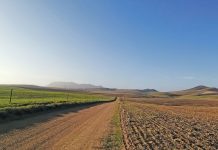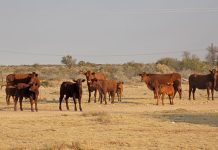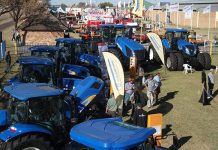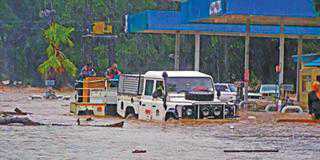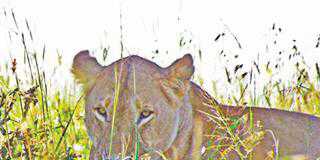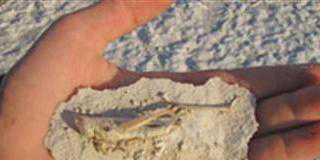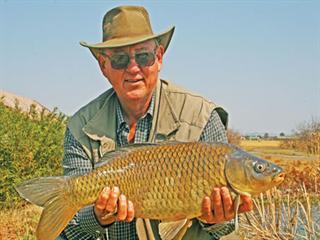
Carp fishing is the favourite outdoor activity of tens of thousands of men, women, children, young and old. They can be seen on the shores of our dams and rivers every weekend, and often on weekdays as well, casting with all their might as far out as possible in search of South Africa’s most popular freshwater fish. At the end of their lines is an astounding variety and combination of terminal tackle and bait, which suppliers have promised will be “the one that carp cannot resist”.
Since its introduction in the 1950s, the carp (Cyprinus carpio) has dominated the recreational inland fishing industry. It’s easy to understand its attraction – it’s a beautiful fish with bright orange fins, mostly fully scaled. But more importantly, it also has another attribute – the huge size to which it can grow. With enough space, oxygen, food and time, it easily attains more than 10kg.
Dedicated carp anglers do not speak of kilograms, preferring pounds as used in England, arguably the home of carp fishing. In South Africa, with modern techniques, tactics and tackle, 30 pounders and 40 pounders are now regularly caught. The carp has colonised just about every water body in the country. It is highly adaptable and can withstand extremes of heat and cold, as well as industrial and agricultural water pollution. Indeed, in the US, biologists during the years of heavy pollution in the previous century reckoned that after all the other fish had died, there would still be carp around.
Tackle industry
Recreational and competitive carp angling has spawned a multi-million rand fishing tackle manufacturing, import and distribution industry. Over 99% of all carp tackle and accessories are imported from England, Japan, US and, more recently, from China. The local industry is dominated by bait and bait additive manufacturers, all using the same basic ingredients such as maize and wheat and their derivatives, as well as a bewildering variety of seed.
Two carp groups
Carp anglers can be divided into two distinct categories, namely formal sport and informal recreational groups. The former totals about 7 000 people affiliated to clubs, which in turn are affiliated to provinces affiliated to the South African Freshwater Bank Angling Federation.
Formal angling competitions take place on two levels. Conventional shore anglers – affectionately termed papgooiers (porridge throwers, because they use porridge as bait) – target any species and as many fish as possible during a tournament. Competition carp anglers may only fish for carp that are of the minimum weight which has been decided by the venue.
The informal group, with an estimated participation of close to a million people, is not affiliated to any organisation and comprises two sub-categories. Social anglers fish for all species when, where and with whom they want. Specimen carp anglers fish exclusively for big carp specimens. To date, the former has been the support base of South Africa’s angling industry.
However, the fact that carp is not an indigenous fish drew the ire of purist conservation scientists a few years ago, who advocated that in the interests of preserving SA’s biodiversity, carp had to be eradicated. Subsequent research and plain common sense blew this notion out of the water. Now it is accepted that carp, on which freshwater recreational fishing is largely based, are welcome in the country.
Recent research has proved that recreational carp fishing, as opposed to commercial or subsistence fishing, has huge economic and social advantages for the country. A 2007 study** found that about 1,5 million people were participants, with a total annual economic impact of R3,9 billion. South African competitive carp anglers have also proven themselves in international competitions, winning the World Carp Championships in four consecutive years – in 2008 at Bloemhof Dam, North West, in France in 2009, in England in 2010 and in Italy in 2011.
It is a feat that no other country has achieved and South Africa’s Protea team of competition carp anglers is now internationally recognised. The fish is highly fertile with a female carp producing about 50 000 eggs/kg liveweight annually. By the time hatchlings reach 10cm, they have few predators left.
However, if not managed correctly, carp will soon overpopulate a dam, whether large or small. Overpopulation is arguably the greatest threat to a healthy carp population, so it is advised that all carp less than 5kg be culled. This, of course, flies in the face of the popular but hugely misguided notion of “conservation” and the practice of catch and release, irrespective of the size of the fish.
Possibly the greatest attraction of carp fishing is that it is an activity in which the participant can be seen apparently doing nothing but reclining in a deckchair listening to the cricket score on the radio. In fact, he or she is actually quite busy, because, as long as there is a baited hook in the water, there’s fishing in progress!
** Professor Marius Leibold, PhD, Project Leader, Professor in International Business Management & Private Consultant, and Dr Colin J van Zyl, PhD, Environment & Tourism Specialist, Development Strategies International (Pty) Ltd, Cape Town & London.
Contact Abré J Steyn at [email protected], with “Field Sports” in the subject line.




